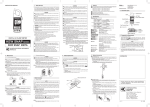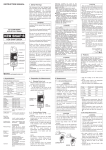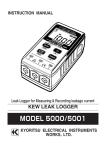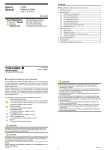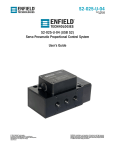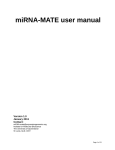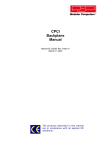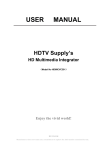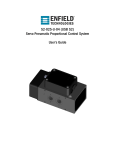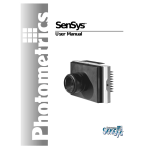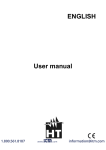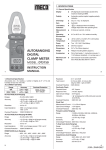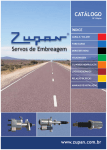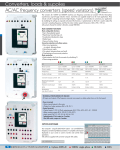Download MODEL 4116A, 4118A, 4120A
Transcript
INSTRUCTION MANUAL DIGITAL PSC-LOOP TESTER MODEL 4116A, 4118A, 4120A KYORITSU ELECTRICAL INSTRUMENTS WORKS,LTD. CONTENTS 1. SAFE TESTING .............................................................................. 1 2. PROCEDURE OF REMOVING COVER ......................................... 3 3. FEATURES ...................................................................................... 4 3.1 Instrument Layout .................................................................... 4 3.2 Test Lead .................................................................................. 5 3.3 Features ................................................................................... 5 4. SPECIFICATIONS .......................................................................... 7 5. OPERATING INSTRUCTIONS ....................................................... 8 5.1 Initial Checks ............................................................................. 8 5.2 Measurement of the Loop Impedance ...................................... 9 5.3 Measurement of Prospective Short Circuit Current ................. 10 6. DETAILED EXPLANATION ........................................................... 10 6.1 Measurement of Fault Loop Impedance and Prospective Fault Current ....................................................... 10 6.2 Measurement of OLD-TT System ............................................ 15 6.3 Measurement of Line Impedance and Prospective Short Circuit Current ............................................ 16 7. SERVICING ................................................................................... 17 8. CASE AND STRAP BELT ASSEMBLY ......................................... 17 1. SAFE TESTING Electricity is dangerous and can cause injury and death. Always treat it with the greatest of respect and care. If you are not quite sure how to proceed, stop and take advice from a qualified person. This instruction manual contains warnings and safety rules which must be observed by the user to ensure safe operation of the instrument and retain it in safe condition. Therefore, read through these operating instructions before using the instrument. IMPORTANT: 1. This instrument must only be used by a competent and trained person and operated in strict accordance with the instructions. KYORITSU will not accept liability for any damage or injury caused by misuse or non-compliance with the instructions or with the safety procedures. 2. It is essential to read and to understand the safety rules contained in the instructions or with the safety procedures. 3. The symbol indicated on the instrument means that the user must refer to the related sections in the manual for safe operation of the instrument. Be sure to carefully read instructions following each symbol in this manual. DANGER is reserved for conditions and actions that are likely to cause serious or fatal injury. WARNING is reserved for conditions and actions that can cause serious or fatal injury. CAUTION is reserved for conditions and actions that can cause a minor injury or instrument damage. ―1― DANGER ● This instrument is intended only for use in single phase operation at 230V +10% -15% AC phase to earth or for use in OLD-TT system phase to neutral. ● When conducting tests do not touch any exposed metalwork associated with the installation. Such metalwork may become live for the duration of the test. ● When testing, always be sure to keep your fingers behind the safety barriers on the test leads. ● Be sure to remove the test lead from the mains power supply promptly after measurement. Do not leave the instrument connected to the mains power supply for a long time. WARNING ● Never open the instrument case - there are dangerous voltages present. If a fault develops, return the instrument to your distributor for inspection and repair. ● If the overheat symbol appears in the display ( ) disconnect the instrument from the mains supply and allow to cool down. ● If abnormal conditions of any sort are noted (such as a faulty display, unexpected readings, broken case, cracked test leads, etc) do not use the tester and return it to your distributor for repair. ● Never attempt to use the instrument if the instrument or your hand is wet. CAUTION ● For those testers without the D-LOK circuitry (models 4116A, 4118A) all RCD's (RCCB, ELCB) in the circuit must be by-passed for the duration of the test (except on loop-2000Ω range). Do not operate the RCD Test Button with the RCD by-passed. ● During testing it is possible that there may be a momentary degradation of the reading due to the presence of excessive transients or discharges on the electrical system under test. Should this be observed, the test must be repeated to obtain a correct reading. If in doubt, contact your distributor. ● Use a damp cloth and detergent for cleaning the instrument. Do not use abrasives or solvents. ―2― 2. PROCEDURE OF REMOVING COVER Model 4116A, 4118A and 4120A have a dedicated cover to protect against an impact from the outside and prevent the operation part, the LCD and the connector socket from becoming dirty. The cover can be detached and put on the back side of the main body during measurement. 2.1 Method of removing the cover Fig. 1 2.2 Method of housing the cover Fig. 2 ―3― 3. FEATURES 3.1 Instrument Layout ⑤ ① ② Wiring correct (Green LED's) Reversed L/N terminals (Red LED) ③ ④ Connector LCD Fig. 3 1............ LCD display 2............ Wiring check LEDs 3........... Test button 4............ Range switch 5............ Connector DANGER ● Use original test lead only. ● Max. allowed voltage between mains test terminals and ground is 300V. ● This instrument is intended only for use in single phase operation at 230V +10% -15% AC phase to earth or for use in OLD-TT system phase to neutral. ―4― 3.2 Test Lead The instrument is supplied with Model 7125 lead at socket outlets and Model 7121 distribution board lead. (1) Model 7125 (2) Model 7121(Included as standard equipment for M-4118A and 4120A. Optional for M-4116A.) Black-Neutral Red-Phase Green-Earth Fig.4 3.3 Features 3.3-1 Test Range (Function): Model D-LOK Circuit * Loop 0-19.99Ω/ 0-199.9Ω/0-1999Ω PSC 0-199.9A/ 0-1999A/0-4.00kA M-4120A ○ M-4118A × M-4116A × ○ ○ ○ ○ ○ × Note: ● *D-LOK=Automatic device (RCD) lock ● D-LOK dose not operate on the Loop-2000Ω. ● Mains voltage with which D-LOK operates is as shown in the table below. Range Loop200Ω/PSC200A Loop20Ω/PSC2000A, 20kA D-LOK Operating Voltage 190∼253V 205∼253V 3.3-2 Applied Standards: Instrument operation: Safety: Protection degree: IEC /EN 61557-1, IEC61557-3 IEC/EN 61010-1 CATⅢ(300V) - instrument IEC/EN 61010-2-31 CATⅢ(300V) - test lead IEC60529 (IP 54) ―5― 3.3-3 Model 4116A, 4118A and 4120A have the following features: ● Battery is not used All models are not battery-operated, but operate by the voltage supplied from the system. ● Wiring check Three LEDs indicate if the wiring of the circuit under test is correct. The P-E and P-N LEDs illuminate when the wiring polarity of the circuit under test is correct. The Reverse LED is lit when P and N are reversed. ● Over temperature Detects overheating of the internal resistor displaying a warning symbol ( ) and automatically protection halting further measurements. ● Overload protection Halts measurement to prevent damages to the body when voltage between VL-PE is 260V or more. "VL-PE Hi" is shown on the display. ● D-LOK circuit Model 4120A with unique D-LOK circuit avoids the need to by-pass most RCD's. ● 15mA Loop Loop impedance 2000Ω range measurement is carried out with low test current (15mA). The measurement current will not cause tripping out involved RCD even the one with the lowest nominal differential current (30mA). ● Display The liquid crystal display has 3 1/2 digits with a decimal point and units of measurement (Ω, A, kA,V). ● Manual and Autotest mode Manual − Press and release the "Press to Test" button. The result will be displayed for 3s and then the display will revert to AC voltage. Autotest − The "Press to Test" button can be turned clockwise to lock it down. In this auto mode, when using distribution board lead M-7121, tests are conducted by simply disconnecting and reconnecting the red phase prod of the M-7121 avoiding the need to physically press the test button i.e. "hands free". CAUTION ● The D-LOK circuits may not by-pass some RCD's and this will result in the RCD tripping out as they would do with a conventional loop tester. Also, in the case of high sensitivity RCD's rated at 10mA or less the D-LOK circuits may not function. ―6― 4. SPECIFICATIONS ● Measurement Specification Loop Impedance ( IEC61557-3) Range 20Ω 200Ω 2000Ω Measuring range 0.00∼19.99Ω 0.0 ∼199.9Ω 0 ∼1999Ω Nominal test current at 0Ω external loop 25A / 20ms 2.3A / 40ms 15mA /280ms Accuracy ±(2%rdg + 4dgt) Prospective Short-circuit Current (M-4118A, M-4120A) Nominal test current Range Accuracy Measuring range at 0Ω external loop 2.3A / 40ms 200A 0.0 ∼199.9A Consider accuracy 25A / 20ms 2000A 0 ∼1999A of Loop Impedance 25A / 20ms 20kA 0.00 ∼ 4.00kA Voltage Measuring range 110 ∼ 260V Instrument dimensions Instrument weight Reference conditions Operating temperature and humidity Storage temperature and humidity Symbols used on the instrument Accuracy ±(2%rdg + 4dgt) 186×167×89mm M-4120A / 960g, M-4116A and M-4118A / 750g Specifications are based on the following conditions except where otherwise stated: 1. Ambient temperature: 23 ± 5 ℃ 2. Relative humidity:45% to 75% 3. Position: horizontal 4. AC power source: 230V, 50Hz 5. Altitude: Up to 2000m 0 to +40℃, relative humidity 80% or less, no condensation. −20 to +60℃, relative humidity 75% or less, no condensation. Equipment protected throughout by DOUBLE INSULATION or REINFORCED INSULATION. Caution(refer to accompanying instruction manual) ―7― ● Operating Error of Loop Impedance (61557-3) Measuring range to keep Maximum percentage operating error operating error 20Ω 0.20 ∼ 19.99Ω 200Ω ±30% 20.0 ∼ 199.9Ω 2000Ω 200 ∼ 1999Ω The influencing variations used for calculating the operating error are denoted as follows: Temperature:0℃ and 40℃ Phase angle :At a phase angle 0゜to 18゜ System frequency:49.5Hz to 50.5Hz System voltage:230V+10%-15% Range 5. OPERATING INSTRUCTIONS 5.1 Initial Checks - To be carried out before any testing. (1) Test Lead Connection Insert the lead plug into the connector on the instrument correctly as shown below. Lead Plug Fig. 5 CAUTION ● Always inspect your test instrument and lead accessories for abnormality or damage. If abnormal conditions exist DO NOT PROCEED WITH TESTING. (2) Wiring Check Before pressing the "Test Button" always check the LED's for the following sequence: P-E Green LED must be ON P-N Green LED must be ON Red LED must be OFF ―8― WARNING ● If the above sequence is NOT displayed or the RED LED is on for any reason , DO NOT PROCEED AS THERE IS INCORRECT WIRING. The cause of the fault must be investigated and rectified. (3) Voltage Measurement When the instrument is first connected to the system, it will display the phase-neutral voltage which is updated every 1s. This mode is cancelled whenever the test button is pressed. If this voltage is not normal or as expected, DO NOT PROCEED. WARNING ● This instrument is intended only for use in single phase operation at 230V +10% -15% AC phase to earth or for use in OLD-TT system phase to neutral. 5.2 Measurement of the Loop Impedance (1) Set the instrument to the 200Ω or 2000Ω range. If the instrument is set to the 20Ω range slight sparking may occur when testing with the distribution board lead although the unit has been designed to minimize this. (2) Connect the lead to the instrument. (3) Plug the moulded mains plug to the socket being tested. (4) Check the LED's are lit as indicated in section 5.1. If not DO NOT PROCEED - check wiring. (5) Note the mains voltage if required. (6) Press the "Press to Test" button. The value of loop impedance will be displayed with the appropriate units. A bleep will sound on completion of the test. For best results always test on the lowest possible range. For example, a loop impedance measured on the 200Ω range may give an indication of 0.3Ω whereas on the 20Ω range it may read 0.28 Ω. In the event of the reading being in excess of the range (e.g. more than 20Ω on the 20Ω range) the appropriate over-range symbol "OL" will appear on the display. No harm will be done to the instrument by selecting too low a range. ―9― 5.3 Measurement of Prospective Short Circuit Current − (Models 4118A and 4120A) (1) Set the instrument to the 20kA range. (2) Connect the test lead to the instrument. (3) Attach the plug to the socket to be tested. (4) Check that the LED's are lit in the sequence indicated in section 5.1. If not, disconnect from the mains and check the wiring at the socket. (5) Press the "Press to Test" button. The prospective short circuit current (PSC) will be directly displayed on the LCD with the appropriate units. This will remain for 3s and then revert to AC voltage display. An audible beep will sound on completion of the test. For best results always test on the lowest possible range. For example a PSC measured on the 2000A range may read 60A whilst on the 200A range it may read 56.0A. To hold the reading keep the button held down or turn clockwise to lock for Auto Test. Note: ● For loop impedance greater than 210Ω on PSC 200A range and 25 Ω on 2000A, 20kA ranges, the fault voltage may become high and dangerous due to the D-LOK current, therefore, the unit is designed to lock out PSC ranges showing "Uf-Hi" symbol. Normally PSC tests are conducted at point of origin, e.g. distribution boards, between phase and neutral. When conducting PSC tests at socket outlets, a test will be conducted between phase and earth due to the fixed wiring of the moulded mains plug. WARNING ● This instrument is intended only for use in single phase operation at 230V +10% -15% AC phase to earth or for use in OLD-TT system phase to neutral. 6. DETAILED EXPLANATION 6.1 Measurement of Fault Loop Impedance and Prospective Fault Current If the electrical installations are protected by over-current protection devices or by fuses, the Fault loop impedance should be measured. ― 10 ― In the event of a fault, the Fault loop impedance should be low enough (and the Prospective Fault current higher enough) in order to have the automatic disconnection of supply by the installed protection device within prescribed time interval. Every circuit must be tested to make sure that the fault loop impedance does not exceed that specified for the over current protection device concerned. For TT system the Fault loop impedance is the sum of the following partial impedances: ¡ Impedance of power transformer's secondary. ¡ Phase conductor resistance from power transformer to fault location. ¡ Protection conductor resistance from fault location to local earth system. ¡ Resistance of local earth system R. ¡ Resistance of power transformer's earth system Ro. The figure below shows in marked line the Fault loop impedance for TT system. Fig.6 For TN system the Fault loop impedance is the sum of the following partial impedances: ¡ Impedance of power transformer's secondary ¡ Phase conductor resistance from power transformer to fault location ¡ Protection conductor resistance from fault location to power transformer ― 11 ― The figure below shows in marked line the Fault loop impedance for TN system. Fig.7 According to the international Standard IEC 60364 for TT system the following condition shall be fulfilled for each circuit: RA<50/Ia Where: ¡ RA is the sum of the resistances of the local earth system R and protection conductor connecting it to the exposed conductive part. ¡ 50 is the max contact voltage limit (it could be 25V in particular cases) ¡ Ia is the current causing the automatic disconnection of the protective device within 5 s. When the protection device is a residual current device (RCD), Ia is the rated residual operating current I ⊿ n. For instance in a TT system protected by a RCD the max RA values are: Rated residual operating current I⊿n. RA (at 50V) RA (at 25V) 10 5000 2500 30 1667 833 100 500 250 300 167 83 500 100 50 1000 50 25 mA Ω Ω Note: ● The loop tester models 4120A / 4118A / 4116A measure the fault loop impedance that is a value normally a little bit higher of RA. But, if the electrical installation is protected considering the loop impedance value, also the RA formula will be fulfilled. ― 12 ― Practical example of verification of the protection in a TT system according to the international Standard IEC 60364. RCD 30mA RO L1 L2 L3 N PE R Fig.8 For this example max value is 1667Ω, the loop tester reads 12.74Ω, it means that the condition RA<50/Ia is respected. It is fundamental for this example to test also the RCD to ensure that operation takes place quickly enough to respect the safety requirements. In order to do it, can be used the RCD tester model 5406A. According to the international Standard IEC 60364 for TN system the following condition shall be fulfilled for each circuit: Zs<Uo/Ia Where: ¡ Zs is the Fault loop impedance. ¡ Uo is the nominal voltage between phase to earth. ¡ Ia is the current causing the automatic disconnection of the protective device within the time stated in table as follows: Uo (Volts) 120 230 400 >400 T (seconds) 0.8 0.4 0.2 0.1 Note: ● For a distribution circuit a disconnection time not exceeding 5s is permitted. ● When the protection device is a residual current device (RCD), Ia is the rated residual operating current I⊿n. ― 13 ― For instance in a TN system with nominal mains voltage Uo = 230 V protected by gG fuses the Ia and max Zs values could be: Rating (A) 6 10 16 20 25 32 40 50 63 80 100 Disconnecting time 5s Disconnecting time 0.4s Ia (A) Zs (Ω) Ia (A) Zs (Ω) 28 8.2 47 4.9 46 5 82 2.8 65 3.6 110 2.1 85 2.7 147 1.56 110 2.1 183 1.25 150 1.53 275 0.83 190 1.21 320 0.72 250 0.92 470 0.49 320 0.71 550 0.42 425 0.54 840 0.27 580 0.39 1020 0.22 Using the current ranges on models 4120A and 4118A can be also tested the Prospective Fault current. Prospective Fault current measured by instruments must be higher than Ia of the protective device concerned Practical example of verification of the protection in a TN system according to the international Standard IEC 60364. Fuse gG 16A RO Fig.9 ― 14 ― L1 L2 L3 N PE Max value of Zs for this example is 2.1Ω (16A gG fuse, 0.4s) the loop tester reads 1.14Ω (or 202 A on Fault current range) it means that the condition Zs <Uo/Ia is respected. In fact the Zs of 1.14Ω is less than 2.1Ω (or the Fault current of 202 A is more than Ia of 110A). WARNING ● This instrument is intended only for use in single phase operation at 230V +10% -15% AC phase to earth or for use in OLD-TT system phase to neutral. ● If the overheat symbol appears in the display ( ) disconnect the instrument from the mains supply and allow to cool down. 6.2 Measurement of "OLD-TT System" OLD-TT system is a TT system with phase to phase voltage of 220 V (instead of 400 V) and phase to earth of 127 V (instead of 230V) and normally the neutral conductor is not used. Connecting the loop testers to this system, all three wiring check LEDs should be lit and the display reads a value of 127 V. Only if all these conditions are respected the test can be carry out. RCD 30mA L1 L2 L3 PE RO R Fig.10 ― 15 ― 220V 220V 220V WARNING (OLD-TT system only) ● DO NOT PRESS the "Test button" if the display reads a value of 220V! The RCD could trip during the tests also with model 4120A. CAUTION ● The D-LOK circuit of 4120A can not works with 127V between phase to earth. 6.3 Measurement of Line Impedance and Prospective Short Circuit Current Line Impedance on single-phase system is the impedance measured between phase and neutral terminals. Measurement principle used inside the instrument is exactly the same as at Fault Loop Impedance measurement, but the measurement is carried out between L and N terminals. Breaking current capacity of installed over-current protection devices should be higher than Prospective Short-Circuit current, otherwise it is necessary to change the rated current of involved over-current protection device. Practical example of line impedance test and prospective short-circuit current test (only for models 4120A and 4118A): The figure below shows in marked line the Line impedance phase to neutral for TN system. RCD L1 L2 L3 N PE L PE N RO Fig.11 ― 16 ― WARNING ● This instrument is intended only for use in single phase operation at 230V +10% -15% AC phase to earth or for use in OLD-TT system phase to neutral. ● If the overheat symbol appears in the display ( ) disconnect the instrument from the mains supply and allow to cool down. ● When testing installation that has a large current capacity, such as a power line, be sure not to short live conductors with the tip of a probe. Failure to follow these instruction can cause hazards to the user. 7. SERVICING If this tester should fail to operate correctly, return it to your distributor stating the exact nature of the fault. Please remember to give all the information possible concerning the nature of the fault, as this will mean that the instrument will be serviced and returned to you more quickly. 8. CASE AND STRAP BELT ASSEMBLY Correct assembly is shown in Fig 12. By hanging the instrument round the neck, both hands will be left free for testing. Pass the strap belt down through the side panel of the main body from the top, and up through the slots of the probe case from the bottom. Fig.12 ― 17 ― Pass the strap through the buckle, adjust the strap for length and secure. DISTRIBUTOR 92-1483 01-05 Kyoritsu reserves the rights to change specifications or designs described in this manual without notice and without obligations. R KYORITSU ELECTRICAL INSTRUMENTS WORKS, LTD. No.5-20, Nakane 2― chome, Meguro-ku, Tokyo, 152-0031 Japan Phone: (03) 3723― 0131 Telex:0246― 6703 Fax: (03) 3723― 0152 Cable Address:"KYORITSUKEIKI"TOKYO URL:http://www.kew-ltd.co.jp E-mail:[email protected] Factories:Uwajima&Ehime























